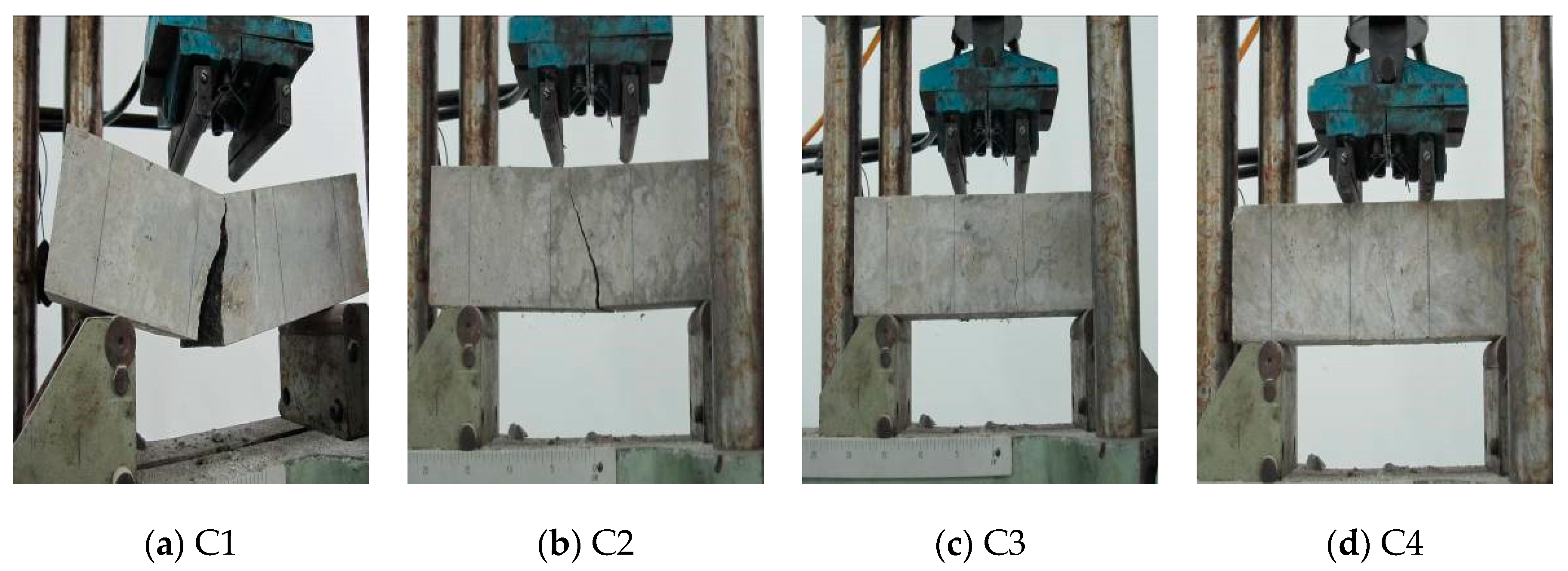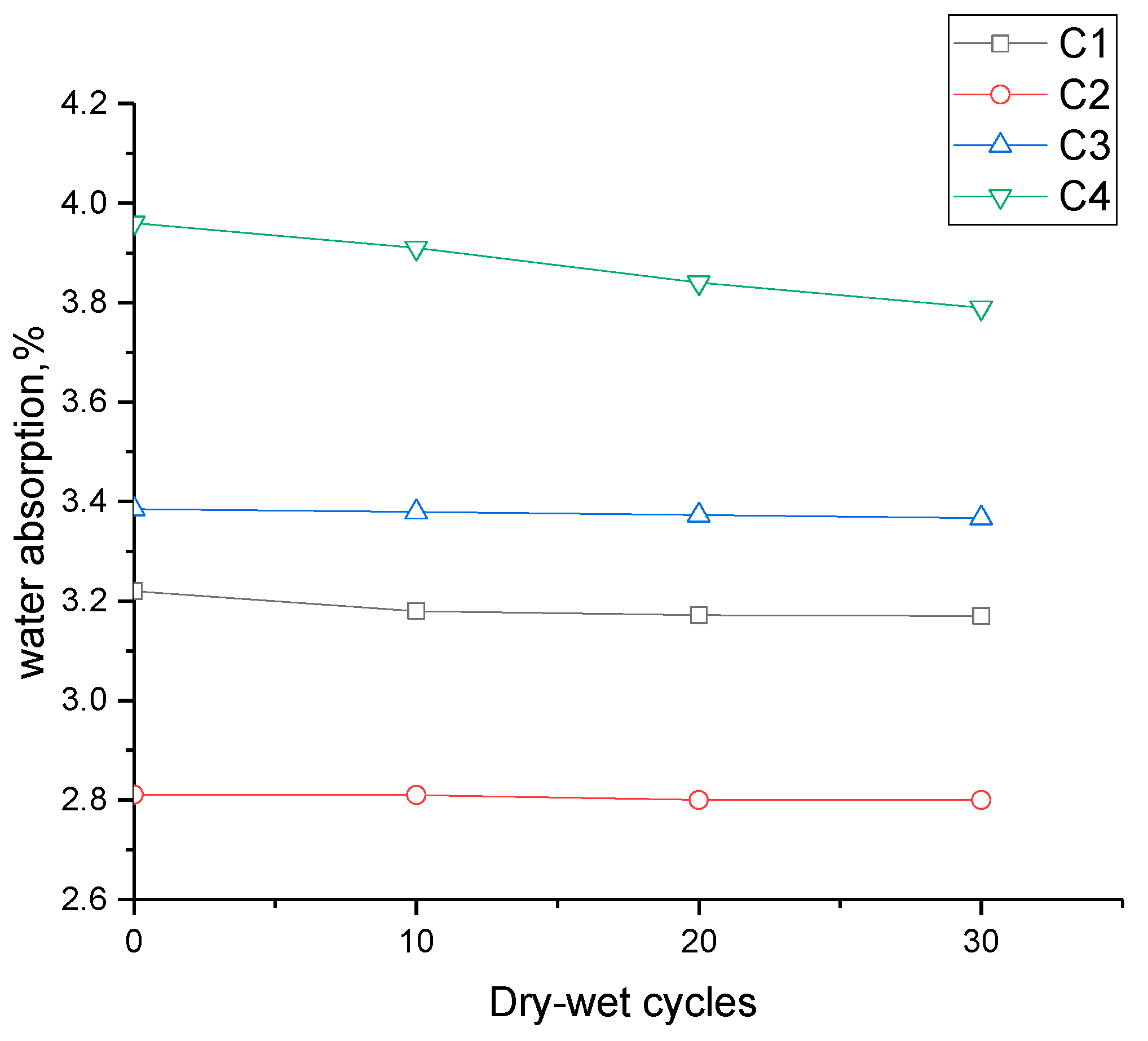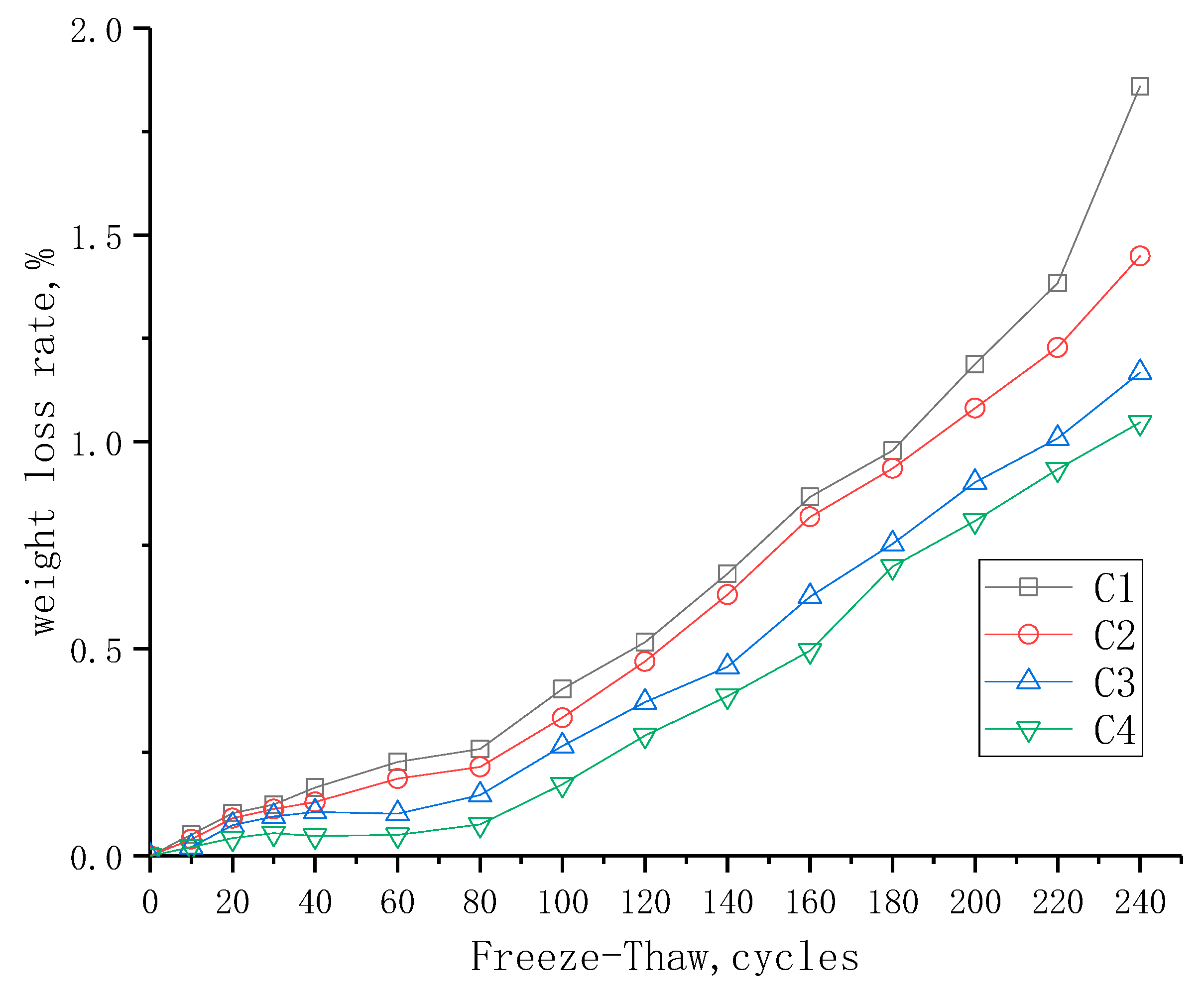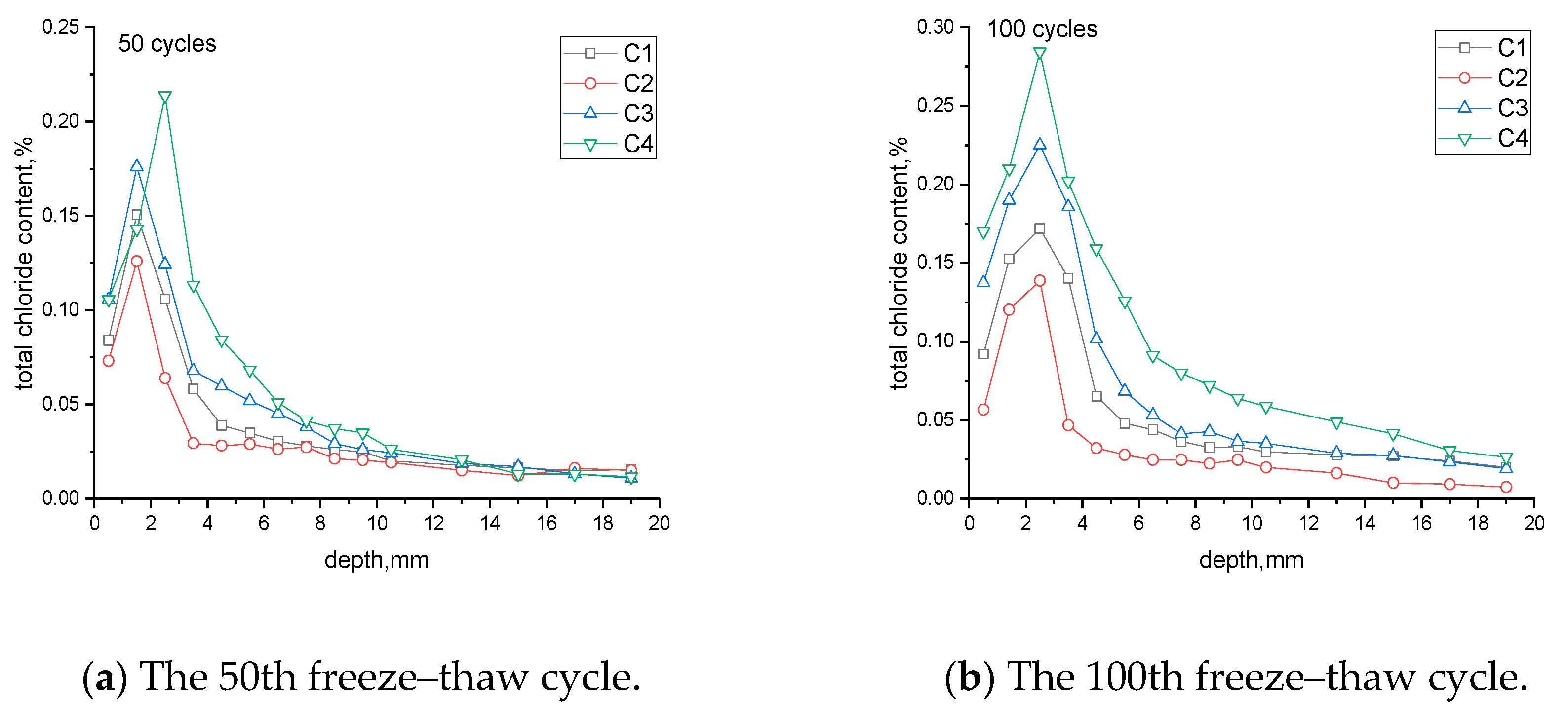Influence of the Fiber Volume Content on the Durability-Related Properties of Polypropylene-Fiber-Reinforced Concrete
Abstract
1. Introduction
2. Materials and Methods
2.1. Materials
2.2. Component Amounts in the Samples and Specimen Preparation
2.3. Exposure to Dry–Wet Cycles
2.4. Exposure to Freeze–Thaw Cycles
2.5. Capillary Absorption and Chloride Penetration
3. Results and Discussion
3.1. Flexural Strength
3.2. Water Absorption
3.3. Scaling
3.4. Relative Dynamic Modulus of Elasticity
3.5. Chloride Profile in the PPF Concrete
3.6. Microstructure Observations
3.7. Chloride Diffusion Coefficient
4. Conclusions
- (1)
- As PPFs are added, no brittle failure occurs when the specimen reaches the ultimate strength. The flexural strength of specimen C3 with 0.3% fiber content is the highest obtained herein. The PPFs reduce the primary cracks in the plastic phase, and the flexural strength of the specimen is improved.
- (2)
- After 30 dry–wet cycles, the water absorption of C2 with 0.1% fiber content is the lowest herein. A sufficient number of fibers can effectively improve the compactness of the specimen and reduce the internal porosity, while a high content of fiber reduces the compactness of the specimens.
- (3)
- After 240 freeze–thaw cycles, specimen C4 with 0.5% fiber content shows the best salt freezing resistance herein. The increase in the fiber content alleviates the ice crystal pressure in the specimens and inhibits the extension of the microcracks.
- (4)
- The free chloride content of specimen C2 is the lowest herein for both the dry–wet and freeze–thaw cycling in chloride environments. During dry–wet cycling, the result can be explained by the “ink-bottle-beam tube” microstructure in concrete. During freeze–thaw cycling, the result can be explained by the transport mechanism in the deicing salt environment. The compact microstructure of specimen C2 inhibits the chloride ions from migrating with the moisture. The SEM images of specimens confirm this result.
- (5)
- The Dcl increases with increasing fiber content in a chloride environment except in specimen C2, and the Dcl during freeze–thaw cycling is much higher than that during dry–wet cycling. Chloride ions migrate with moisture during both freeze–thaw and dry–wet cycling, and the movement of the moisture is much more violent during freeze–thaw cycling than during dry–wet cycling.
- (6)
- For practical applications, PPFC structures are exposed to both dry–wet cycles and freeze–thaw cycles with NaCl solutions. For a realistic prediction of service life, it is necessary to take the combination of dry–wet cycles and freeze–thaw cycles under chloride environments into consideration.
Author Contributions
Funding
Acknowledgments
Conflicts of Interest
References
- Hannawi, K.; Bian, H.; Prince-Agbodjan, W.; Raghavan, B. Effect of different types of fibers on the microstructure and the mechanical behavior of ultra-high performance fiber-reinforced concretes. Compos. Part B Eng. 2016, 86, 214–220. [Google Scholar] [CrossRef]
- Yu, K.-Q.; Yu, J.-T.; Dai, J.-G.; Lu, Z.-D.; Shah, S.P. Development of ultra-high performance engineered cementitious composites using polyethylene (PE) fibers. Constr. Build. Mater. 2018, 158, 217–227. [Google Scholar] [CrossRef]
- Medina, N.F.; Barluenga, G.; Hernández-Olivares, F. Enhancement of durability of concrete composites containing natural pozzolans blended cement through the use of polypropylene fibers. Compos. Part B Eng. 2014, 61, 214–221. [Google Scholar] [CrossRef]
- Khan, R.A.; Sharma, R. Strength and durability characteristics of rice husk ash concrete reinforced with polypropylene fibers. Jordan J. Civ. Eng. 2018, 12, 653–668. [Google Scholar]
- Karahan, O.; Atiş, C.D. The durability properties of polypropylene fiber reinforced fly ash concrete. Mater. Des. 2011, 32, 1044–1049. [Google Scholar] [CrossRef]
- Islam, G.M.S.; Gupta, S.D. Evaluating plastic shrinkage and permeability of polypropylene fiber reinforced concrete. Int. J. Sustain. Built Environ. 2016, 5, 345–354. [Google Scholar] [CrossRef]
- Zhang, P.; Li, Q.-F. Effect of polypropylene fiber on durability of concrete composite containing fly ash and silica fume. Compos. B Eng. 2013, 45, 1587–1594. [Google Scholar] [CrossRef]
- Tuutti, K. Corrosion of Steel in Concrete; Swedish Cement and Concrete Research Institute: Stockholm, Sweden, 1982. [Google Scholar]
- Fang, J.; Ishida, T.; Yamazaki, T. Quantitative evaluation of risk factors affecting the deterioration of RC deck slab components in East Japan and Tokyo regions using survival analysis. Appl. Sci. 2018, 8, 1470. [Google Scholar] [CrossRef]
- China Architectural Scientific. Standard for Technical Requirements and Test Method of Sand and Crushed Stone (or Gravel) for Ordinary Concrete; JGJ 52-2006; Ministry of Housing and Urban-rural Development of China: Beijing, China, 2006.
- China Architectural Scientific. Standard for Test Methods of Long-Term Performance and Durability of Ordinary Concrete; GB/T 50082; Ministry of Housing and Urban-rural Development of China: Beijing, China, 2009.
- Ministry of Communications of China (MCC). JTJ 270-98: Testing Code of Concrete for Port and Waterway Engineering; Profession Standard of the People’s Republic of China: Beijing, China, 1998. [Google Scholar]
- Li, W.; Pour-Ghaz, M.; Castro, J.; Weiss, J. Water absorption and critical degree of saturation relating to freeze-thaw damage in concrete pavement joints. J. Mater. Civ. Eng. 2012, 24, 299–307. [Google Scholar] [CrossRef]
- Qian, Y.; Farnam, Y.; Weiss, J. Using acoustic emission to quantify freeze–thaw damage of mortar saturated with NaCl solutions. In Proceedings of the 4th International Conference on the Durability of Concrete Structures; Purdue University Libraries Scholarly Publishing Services: West Lafayette, IN, USA, 2014; pp. 32–37. [Google Scholar] [CrossRef][Green Version]
- Farnam, Y.; Bentz, D.; Sakulich, A.; Flynn, D.; Weiss, J. Measuring freeze and thaw damage in mortars containing deicing salt using a low-temperature longitudinal guarded comparative calorimeter and acoustic emission. Adv. Civ. Eng. Mater. 2014, 3, 20130095. [Google Scholar] [CrossRef]
- Powers, T.C.; Willis, T.F. The air requirement of frost-resistant concrete. Highw. Res. Board 1950, 29, 184–211. [Google Scholar]
- Powers, T.C. A working hypothesis for further studies of frost resistance of concrete. J. Proc. Am. Concr. Inst. 1945, 41, 245–272. [Google Scholar] [CrossRef]
- Mehta, P.K.; Monteiro, P.J. Concrete: Microstructure, Properties, and Materials; McGraw-Hill: New York, NY, USA, 2005. [Google Scholar]
- Jacobsen, S.; Sœther, D.H.; Sellevold, E.J. Frost testing of high strength concrete: Frost/salt scaling at different cooling rates. Mater. Struct. 1997, 30, 33–42. [Google Scholar] [CrossRef]
- Valenza, J.J.; Scherer, G.W. Mechanisms of salt scaling. Mater. Struct. 2005, 38, 479–488. [Google Scholar] [CrossRef]
- Marchand, J.; Sellevold, E.J.; Pigeon, M. The deicer salt scaling deterioration of concrete—An overview. In Proceedings of the Third International Conference on Durable Concrete, Nice, France, 22–28 May 1994; Malhotra, V.M., Ed.; pp. 1–46. [Google Scholar]
- Ghafoori, N.; Mathis, R.P. Scaling resistance of concrete paving block surface exposed to deicing chemicals. ACI Mater. J. Mater. J. 1997, 94, 32–38. [Google Scholar] [CrossRef]
- Esmaeeli, H.S.; Farnam, Y.; Haddock, J.E.; Zavattieri, P.D.; Weiss, W.J. Numerical analysis of the freeze-thaw performance of cementitious composites that contain phase change material (PCM). Mater. Des. 2018, 145, 74–87. [Google Scholar] [CrossRef]
- Scherer, G.W. Crystallization in pores. Cem. Concr. Res. 1999, 29, 1347–1358. [Google Scholar] [CrossRef]
- Liu, Z.; Hansen, W. Pore damage in cementitious binders caused by deicer salt frost exposure. Constr. Build. Mater. 2015, 98, 204–216. [Google Scholar] [CrossRef]
- Winkler, E.M.; Singer, P.C. Crystallization pressure of salts in stone and concrete. Geol. Soc. Am. Bull. 1972, 83, 3509–3514. [Google Scholar] [CrossRef]
- Wang, Z.; Zeng, Q.; Wang, L.; Yao, Y.; Li, K. Corrosion of rebar in concrete under cyclic freeze–thaw and Chloride salt action. Constr. Build. Mater. 2014, 53, 40–47. [Google Scholar] [CrossRef]
- Muethel, R.W. Investigation of Calcium Hydroxide Depletion as a Cause of Concrete Pavement Deterioration; Michigan Transportation Commission Research Report R-1353; Michigan Transportation Commission: Lansing, MI, USA, 1997. [Google Scholar]
- Jin, W.L.; Yi, Z.; Lu, Z.Y. Mechanism and mathematic modeling of chloride permeation in concrete under unsaturated state. J. Chin. Ceram. Soc. 2008, 36, 1362–1369. [Google Scholar] [CrossRef]
- Andrade, C.; Climent, M.A.; Vera, G. Procedure for calculating the chloride diffusion coefficient and surface concentration from a profile having a maximum beyond tne concrete surface. Mater. Struct. 2015, 48, 863–869. [Google Scholar] [CrossRef]













| Material | CaO | SiO2 | Al2O3 | Fe2O3 | MgO | SO3 |
|---|---|---|---|---|---|---|
| Cement | 63.02 | 21.2 | 5.02 | 4.21 | 2.2 | 2.4 |
| Fly ash | 4.88 | 49.02 | 31.56 | 6.97 | 0.83 | 0.84 |
| Length | Diameter | Density | Elastic Modulus | Tensile Strength | Elongation |
|---|---|---|---|---|---|
| (mm) | (μm) | (g/cm3) | (MPa) | (MPa) | (%) |
| 19 | 20 | 0.91 | 3800 | 270 | 8 |
| Type | Cement | Stone | Sand | Fly Ash | Fiber Volume | Water |
|---|---|---|---|---|---|---|
| (kg/m3) | (kg/m3) | (kg/m3) | (kg/m3) | (%) | (kg/m3) | |
| C1 | 375 | 1048 | 720 | 85 | 0 | 180 |
| C2 | 375 | 1048 | 720 | 85 | 0.1 | 180 |
| C3 | 375 | 1048 | 720 | 85 | 0.3 | 180 |
| C4 | 375 | 1048 | 720 | 85 | 0.5 | 180 |
| Specimen | Batch | Fiber Volume (%) | Flexural Strength (MPa) | ||
|---|---|---|---|---|---|
| FT0 | FT50 | FT100 | |||
| C1 | 1 | 0 | 6.06 | 5.53 | 4.93 |
| 2 | 0 | 5.91 | 5.35 | 4.76 | |
| 3 | 0 | 5.86 | 5.03 | 4.63 | |
| mean | 0 | 5.94 | 5.3 | 4.77 | |
| C2 | 1 | 0.1 | 6.54 | 6.19 | 5.81 |
| 2 | 0.1 | 6.38 | 6.08 | 5.68 | |
| 3 | 0.1 | 6.17 | 5.91 | 5.53 | |
| mean | 0.1 | 6.36 | 6.06 | 5.67 | |
| C3 | 1 | 0.3 | 6.29 | 5.86 | 5.27 |
| 2 | 0.3 | 6.21 | 5.72 | 5.14 | |
| 3 | 0.3 | 6.08 | 5.61 | 5.08 | |
| mean | 0.3 | 6.19 | 5.73 | 5.16 | |
| C4 | 1 | 0.5 | 5.73 | 5.51 | 5.19 |
| 2 | 0.5 | 5.61 | 5.41 | 5.03 | |
| 3 | 0.5 | 5.47 | 5.26 | 4.91 | |
| mean | 0.5 | 5.60 | 5.39 | 5.04 | |
© 2020 by the authors. Licensee MDPI, Basel, Switzerland. This article is an open access article distributed under the terms and conditions of the Creative Commons Attribution (CC BY) license (http://creativecommons.org/licenses/by/4.0/).
Share and Cite
Wang, C.; Guo, Z.; Niu, D. Influence of the Fiber Volume Content on the Durability-Related Properties of Polypropylene-Fiber-Reinforced Concrete. Sustainability 2020, 12, 549. https://doi.org/10.3390/su12020549
Wang C, Guo Z, Niu D. Influence of the Fiber Volume Content on the Durability-Related Properties of Polypropylene-Fiber-Reinforced Concrete. Sustainability. 2020; 12(2):549. https://doi.org/10.3390/su12020549
Chicago/Turabian StyleWang, Chenfei, Zixiong Guo, and Ditao Niu. 2020. "Influence of the Fiber Volume Content on the Durability-Related Properties of Polypropylene-Fiber-Reinforced Concrete" Sustainability 12, no. 2: 549. https://doi.org/10.3390/su12020549
APA StyleWang, C., Guo, Z., & Niu, D. (2020). Influence of the Fiber Volume Content on the Durability-Related Properties of Polypropylene-Fiber-Reinforced Concrete. Sustainability, 12(2), 549. https://doi.org/10.3390/su12020549





